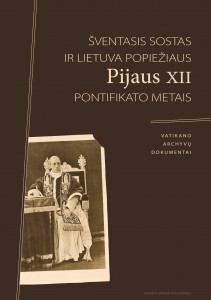Šventasis Sostas ir Lietuva popiežiaus Pijaus XII pontifikato metais. Vatikano archyvų dokumentai
Qty
Popiežiaus Pranciškaus sprendimu nuo 2020 m. kovo 1 d. tyrinėtojams buvo atverti centrinių bažnytinių archyvų fondai, kuriuose saugomi vieno iš jo pirmtakų, popiežiaus Pijaus XII pontifikato laikotarpio (1939–1958) dokumentai. Sprendimas sukėlė didžiulį susidomėjimą ne tik Bažnyčios istorikų bendruomenėje, bet ir platesnėje visuomenėje, nes atliepė pagrįstą lūkestį, kad nauji šaltiniai padės atsakyti į daug diskusijų keliančius klausimus dėl Šv. Sosto užimtų pozicijų Antrojo pasaulinio karo metais ir Šaltojo karo pradžioje. Popiežiaus Pijaus XII laikai sutampa ir su itin dramatiškais XX amžiaus Lietuvos istorijos įvykiais: valstybingumo praradimu ir ginkluotu antisovietiniu pasipriešinimu, totalitarinių okupacinių režimų vykdomu teroru ir grubiu socialinio, kultūrinio bei religinio gyvenimo formų griovimu, nauja lietuvių priverstinės migracijos į Vakarus banga. Šioje knygoje publikuojami Vatikano archyvų dokumentai suteikia unikalią progą pamatyti, kaip šiuos istorinius kataklizmus suvokė ir į juos reagavo įvairių Šv. Sosto institucijų pareigūnai, kokį poveikį ten priimamiems sprendimams galėjo turėti išeivijos dvasininkų ir egzilio diplomatų pastangos. Ypač didelę vertę turi ant spausdintų dokumentų išlikusios rankraštinės anuometinių Vatikano diplomatijos vairininkų pastabos, praskleidžiančios uždangą į uždarą Šv. Sosto institucijų vidaus pasaulį. Kad publikacija pasiektų kuo didesnį suinteresuotų skaitytojų būrį, archyvinių dokumentų perrašai originalo kalbomis čia pateikiami lygiagrečiai su jų vertimais į lietuvių kalbą.
--
Pope Francis has decided to open the central church archives, which contain documents from the pontificate of one of his predecessors, Pope Pius XII (1939-1958), to researchers from 1 March 2020. The decision aroused great interest not only in the community of Church historians but also in the wider public, as it reflected the expectation that the new sources would help to answer the much-debated questions about the Holy See‘s position during the Second World War and the beginning of the Cold War. The reign of Pope Pius XII also coincided with the most dramatic events in the history of 20th century Lithuania: the loss of statehood and armed anti-Soviet resistance, the terror of the totalitarian occupation regimes and the brutal destruction of social, cultural and religious life, and a new wave of forced migration of Lithuanians to the West. The documents from the Vatican archives published in this book provide a unique opportunity to see how these historical cataclysms were perceived and reacted to by the officials of the various institutions of the Holy See, and what impact the efforts of diaspora clergy and diplomats from the exile may have had on the decisions taken there. Of particular value are the handwritten notes on printed documents by the Vatican‘s diplomatic helmsmen of the time, which pierce the veil on the closed world of the inner workings of the institutions of the Holy See. In order to reach as many interested readers as possible, the transcriptions of the archival documents in their original languages are presented here in parallel with their translations into Lithuanian.





